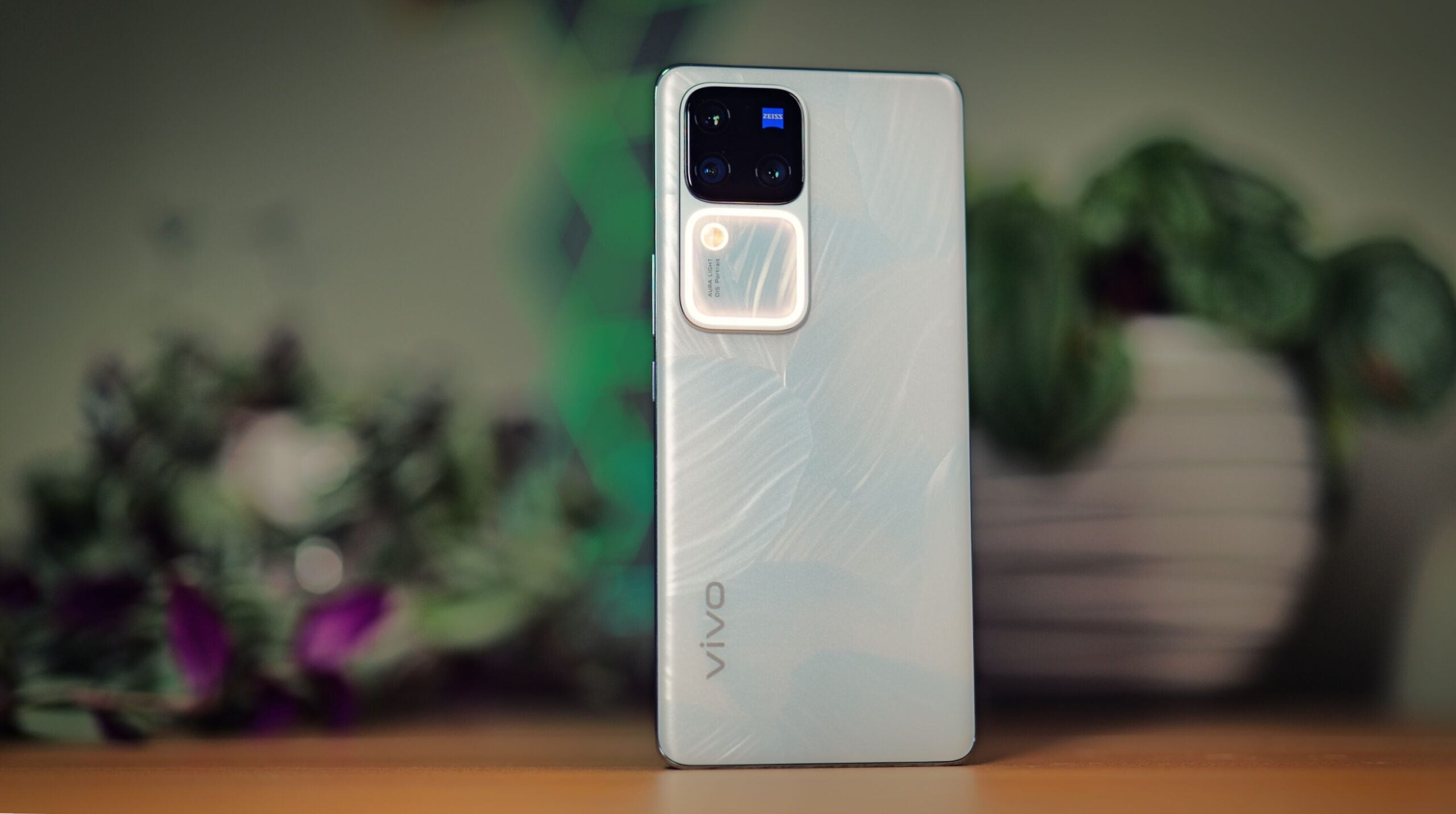Verdict
The Vivo V30 Pro is an affordable midrange handset with cameras that punch well above their weight. Especially the selfie camera, which might just be the best snapper of them all. With limited availability though, getting your hands on one might prove challenging.
Pros
- Triple 50MP camera system
- Slim stylish design
- Fast charging and great battery life
Cons
- Limited availability
- Plenty of bloatware
- Poor stabilisation at 4K@60fps
-
Triple Zeiss camera systemThis is the first V-series phone to benefit from Vivo’s Zeiss partnership, which means it has exclusive filters and bokeh effects just like the X-series. The hardware has been massively upgraded, too. -
Flawless selfiesThe V-series phones are well known for their selfie capabilities and the V30 Pro continues that tradition. It has a 50MP front-facing camera with autofocus that continually impresses. -
Long battery life and 80W chargingNot only does the V30 Pro have stellar battery life, but when you eventually run it down, it charges up in a flash. The powerful 80W wall adapter comes included in the box.
Introduction
Vivo’s V-series phones have impressed over the last few years by offering standout selfie performance at affordable prices. With the latest entrant, the V30 Pro, it looks like that photographic prowess is extending to the rear cameras, too. It’s even sporting a Zeiss logo, just like the brand’s flagship X100 Pro.
The last few generations of V-series devices have had solid main cameras, and great selfie cameras, but they were joined by the lacklustre 8MP ultrawide and 2MP macro combo that we see on so many mid-range phones. This year, things have changed, and every camera has a 50MP resolution. There are three on the back, including a new 2x portrait lens, and of course, a powerful selfie camera with autofocus around the front.
The V30 Pro was initially launched in Thailand and Indonesia, and it’ll be hitting other markets in the near future, but as with previous models, it’s not likely to make its way to the UK. In Thailand, it retails for 19,999 THB (about £440) which means it’s by far the most powerful camera arrangement in its price bracket.
I was intrigued to find out what it’s like to live with and see if the Zeiss magic that we saw with the Vivo X100 Pro has trickled down to this model, too. Here’s what I found out.
Design
- Super slim and lightweight
- Unique colourways and textures
- IP54 rating
Just like previous generations, the Vivo V30 Pro has a striking design and is exceptionally slim. There are four colour options to choose between and the range includes some pretty unique finishes. I have the Bloom White variant in for testing, and it has a 3D-etched pattern that looks like flower petals. It’s a really interesting design, and it’s covered with Vivo’s signature AG glass, so it has the same velvety-smooth feel as the X100 Pro.
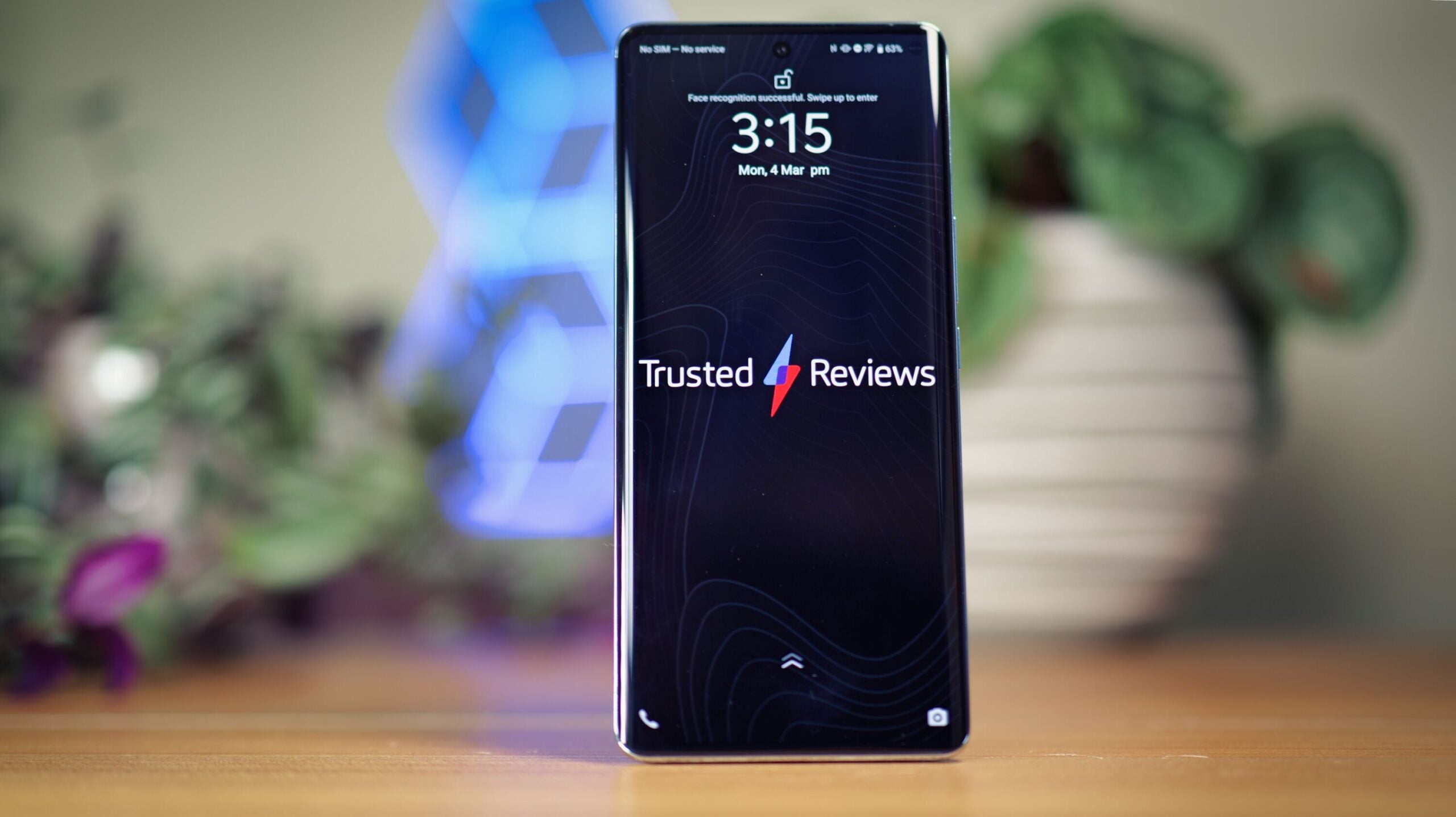
The range also includes a UV-reactive model called Lush Green, which changes shade as the sunlight hits it, something we’ve seen on previous V-series models. Another flashy option is Waving Aqua, which has a shimmering wave-like pattern on the rear panel, that shifts around in different lighting. However, if you prefer a more professional look, you can choose Noble Black, which is just, well, black.
The camera array has a new look this time around, too. All the rear lenses are housed together in a square-shaped black glass panel, accompanied by that fancy Zeiss badge. It’s a bit like the Xiaomi 14 camera layout, only it’s much, much smaller, and barely protrudes at all from the back panel.
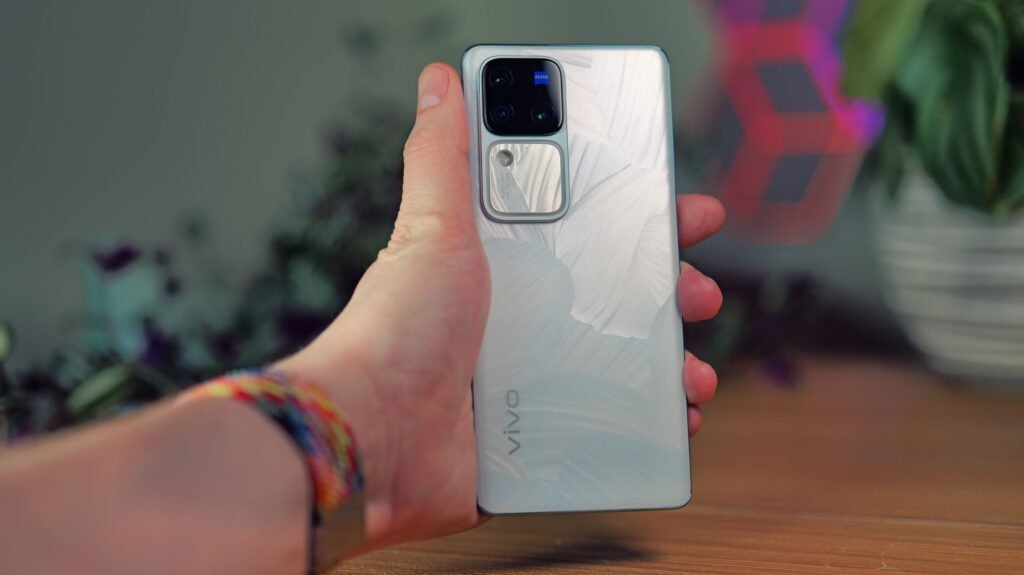
The bi-colour fill light, which Vivo calls Aura Light, makes a return on this model. However, this time it’s square-shaped, to match the camera layout. It also has a larger radius than the ring-shaped fill light on the Vivo V29 Pro, but I’ll explore whether or not that makes a practical difference later on.
As mentioned, it’s a very slim and lightweight handset, and there’s a pronounced curve to both the display edges and the rear panel. It feels great in the hand and in the pocket, but that velvety-feeling AG glass sure is slippery. Thankfully, it comes with a transparent TPU case in the box, and I kept that on most of the time, purely out of fear of dropping it, or having it spontaneously slide off my desk.
Screen
- 6.78-inch 2K 120Hz AMOLED
- 2800 nits peak brightness
- Curved edges, HDR10+support
The Vivo V30 Pro has an excellent AMOLED display with a 1260×2800 resolution and an adaptive refresh rate of 60-120Hz. It’s not quite on the level of LTPO panels, which can drop as low as 1Hz, but it means that you always get a smooth-looking experience without draining your battery excessively.
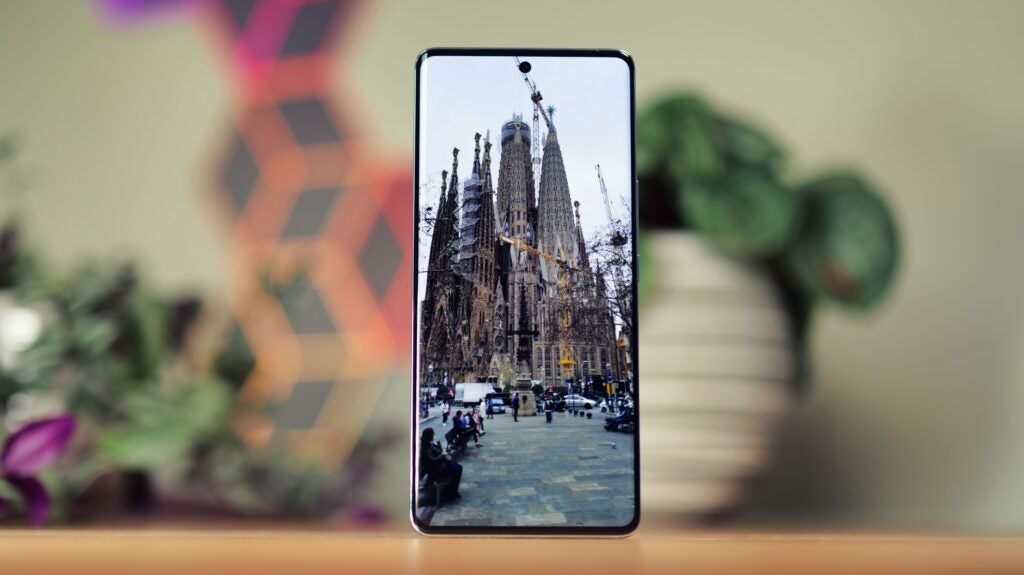
Vivo quotes the peak brightness output at a whopping 2800 nits, however, as usual, it’ll only hit that level during HDR playback in bright environments. Regardless, it’s a very bright panel that can easily compete with direct sunlight.
The phone has the correct Widevine DRM certification to allow apps like Netflix to play in HDR10, and it looks great doing so. Colours are vibrant, shadows are dark and detailed and the highlights shine brightly. No complaints here.
The edges of the display have a fairly pronounced curve, which leads to some slight colour shifting at the periphery. It’s far from the worst I’ve seen, but something to be wary of. In fairness, though, the curves make for a very slim-feeling device, and despite having a large screen, it’s much more manageable for people with smaller hands.
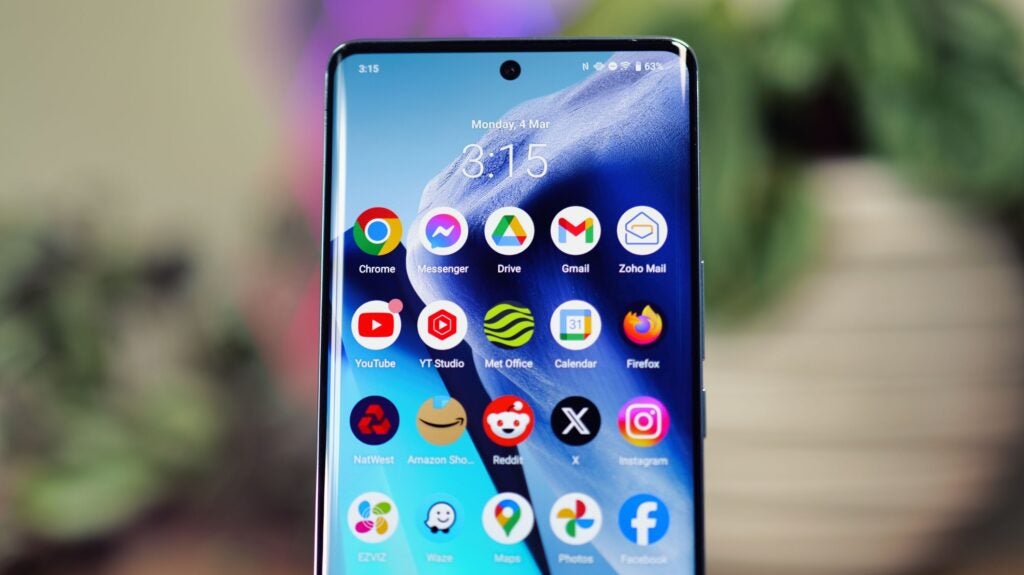
There’s a good amount of customisation in the settings menu so you can tweak the colour rendition to your liking. You get three main profiles to choose from, and you can adjust the colour temperature and tint of each one independently. There’s also a wealth of eye-care options that you can enable.
Cameras
- 50MP 1/1.49-inch f/1.9 main camera
- 50MP ultrawide and 2x portrait lens
- 50MP f/2.0 wide-angle selfie camera with autofocus
The biggest upgrade that this phone offers over its cheaper sibling and previous generations is in the camera setup. The V30 Pro has a trio of 50MP cameras on its rear and a 50MP selfie snapper on the front. It’s also the first model in the V-series to benefit from Vivo’s Zeiss partnership, which brings with it exclusive photo styles and image tuning.
Usually, V-series phones come with the all-too-common mid-range combo of a capable main camera, an 8MP ultrawide, and a 2MP macro. This time, though, the rear cameras have really taken a step up. You get a 1/1.49-inch main sensor with an f/1.9 aperture, an f/1.9 2x telephoto lens, and an f/2.0 ultrawide with a 119-degree FOV and autofocus.
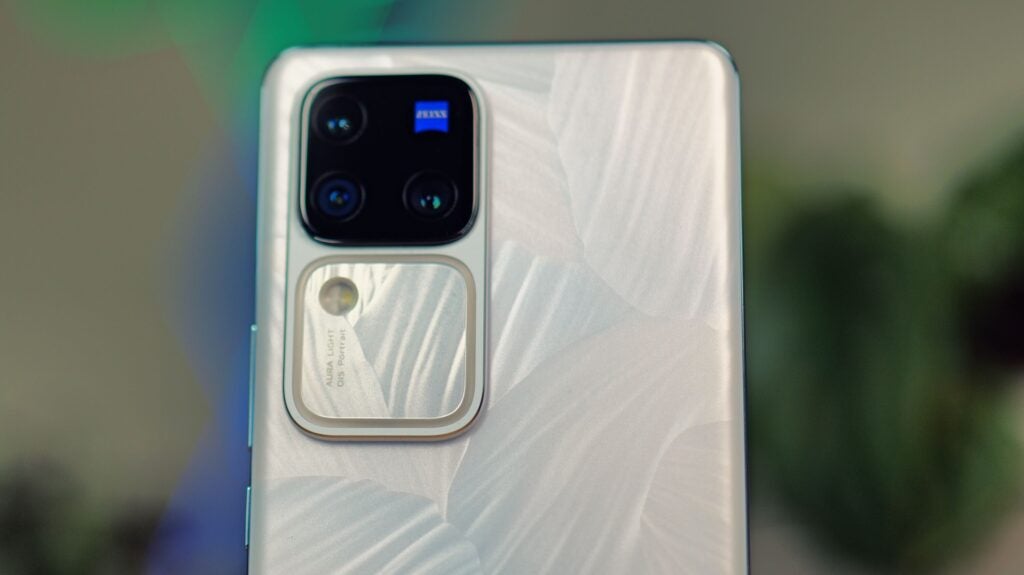
Around the front, the selfie camera has a wide 20mm equivalent lens, and at its widest, Vivo calls it a 0.8x focal length in the UI. However, you can shoot at 1x and 2x with the touch of a button, and since the selfie camera has a whopping 50MP resolution, these crops are effectively lossless.
As was the case with the previous V-series phones that I tested, the selfie camera got me the most excited, and I took way more photos with the front-facing camera than I normally would. The wide FOV makes it perfect for group shots or showing off your surroundings, and since it has autofocus, your images are tack-sharp no matter where you’re standing.


It’s a way better selfie camera than the one on Vivo’s flagship handset, the X100 Pro, and it might just be one of the best selfie cameras on any phone. Impressive stuff, at such an affordable price point.
Around the back, despite all cameras offering a 50MP resolution, the main camera is by far the most impressive. This is especially true when the light gets a little lower, as its larger sensor does a better job of fending off noise and motion blur.
However, the ultrawide and 2x telephoto are both very useful to have. Both of these cameras can focus extremely close, too, allowing for some lovely macro shots that you can’t get with the main camera.
The camera app gives you a 4x button, which takes digitally cropped shots of the 2x optical telephoto, but I was less impressed with these photos. They’re ok if the lighting is perfect, but there’s a definite drop in quality. Your best bet is to move closer with the 2x lens, wherever possible.
The image quality across all cameras is aided by Vivo’s comprehensive suite of image editing tools, filters and beautification options. You can bring photos to life by adding a simple filter, and portrait mode cutouts are pretty reliable, too. It’s worth noting, though, that you can only adjust the bokeh effect after shooting on the rear lenses, which is slightly frustrating when you add too much blur to a selfie snap.
A unique feature of this phone is its Aura Light, which is a bi-colour continuous light source that can illuminate your photos and videos at night. It automatically detects the ambient lighting and adjusts the colour temperature of the LED ring to match, but you can also take control of it manually if you prefer.
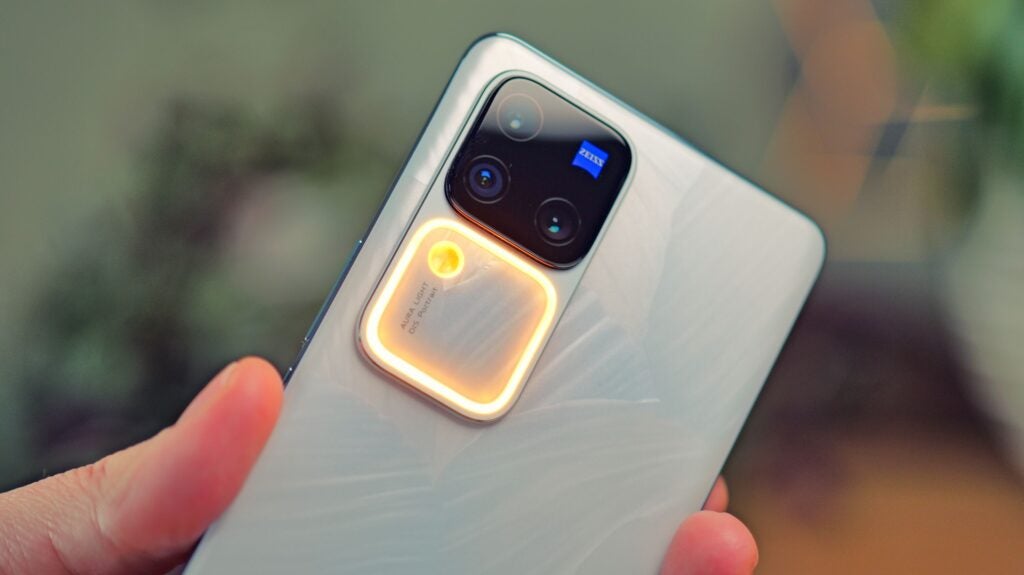
In most situations, the Aura Light illumination doesn’t look too flattering, but it’s definitely a step above the usual LED flash. And in situations where you want a traditional flash, the phone has one of those, too.
For video capture, you can shoot at up to 4K@60fps on all cameras. However, I’d recommend sticking to 4K@30fps, as the stabilisation is far better. It seems like EIS is disabled entirely at 4K@60fps. Enabling Ultra Steady mode smooths things out even more, but then you’re limited to 1080p.
Performance
- MediaTek Dimensity 8200
- 12GB RAM
- 512GB storage
The Vivo V30 Pro runs on the MediaTek Dimensity 8200, and it’s paired with up to 12GB of RAM and 512GB of storage. It’s a sub-flagship chipset, but it’s more than capable enough, and it’ll outshine Qualcomm’s Snapdragon 7 Gen 3 and Google’s Tensor G2 in a lot of situations.
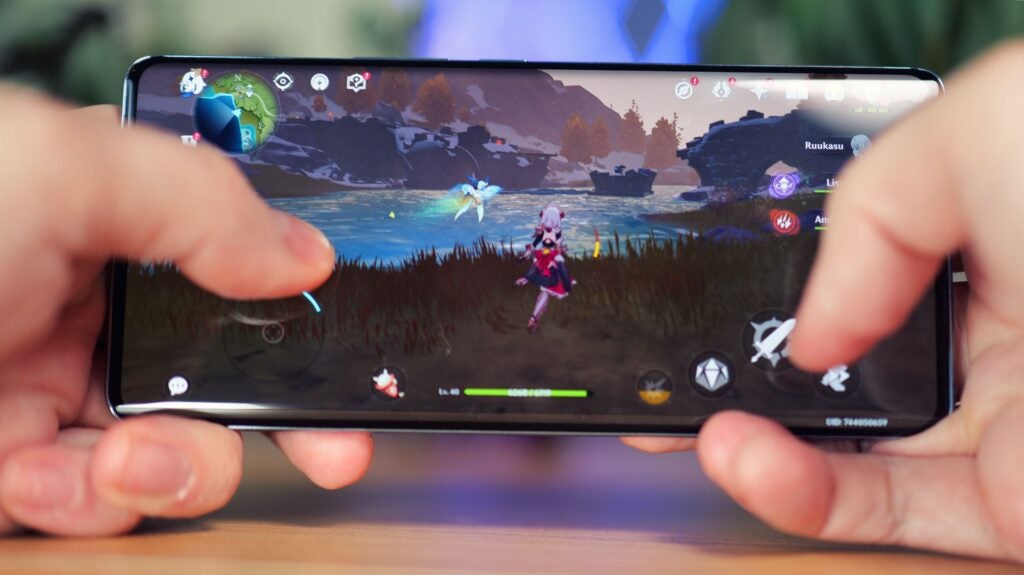
In day-to-day use, I had no complaints about the performance. Apps always opened quickly and navigating the operating system was smooth and stutter-free. I’m testing the 12GB model, and it can multitask like a champ, whether watching YouTube in a pop-out window or streaming a podcast while navigating with Google Maps.
The gaming performance was impressive, too. The phone can happily run Genishin Impact on the High graphics preset at 30fps, and if you switch to the Medium preset, you’ll get a solid 60fps. Of course, you can go higher, but expect some stuttering if you do.
The Vivo V30 Pro only has a single speaker, which is a little disappointing to see, especially after testing the Poco X6 Pro which has decent stereo speakers at a significantly lower MSRP.
That said, this speaker doesn’t sound too bad, and it’s definitely louder than expected. Amusingly the volume goes all the way to 150% if you keep hitting the button, but it begins to distort if you max it out. My main problem with the speaker is that it’s easily muffled if you’re holding the phone in the wrong place, and that can be annoying.
Software
- Funtouch OS 14
- Based on Android 14
- Lots of bloatware
The Vivo V30 Pro runs Funtouch OS 14, which is a skinned version of Android 14. It’s the same software found on the Vivo X100 Pro that lives in my pocket most of the time, so I wasn’t in for too many surprises.
It’s not the most exciting Android skin, but it’s highly customisable, so if you don’t like the way the app icons look, the UI animations or even the shape of the fingerprint reader icon, you can change them with ease.
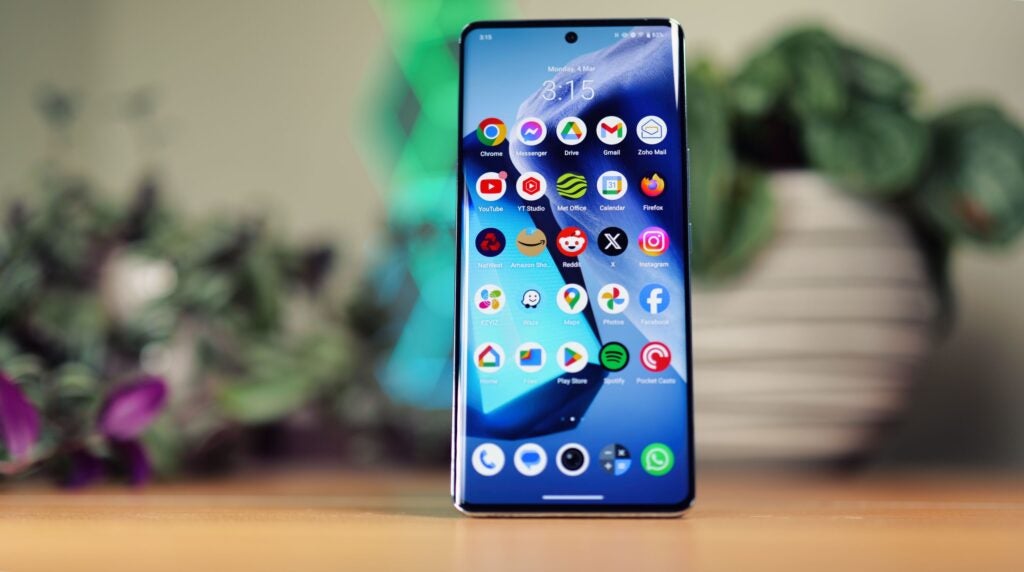
While I praised the flagship X100 Pro for its lack of bloatware, that’s unfortunately not the case with the V30 Pro. It comes packed with all kinds of junk, including folders of “hot apps” and games. It’s not the end of the world; it can all be removed, and it’s somewhat understandable at such an affordable price point, but in an ideal world, it’s a hassle I could do without.
Vivo promises two major OS upgrades and three years of security patches for the V30 Pro. This software support lags behind some of the competition; Poco promises three OS updates and four years of security patches for X6 and X6 Pro, for example. Samsung takes things even further, with five years of security patches on its similarly priced A54 5G.
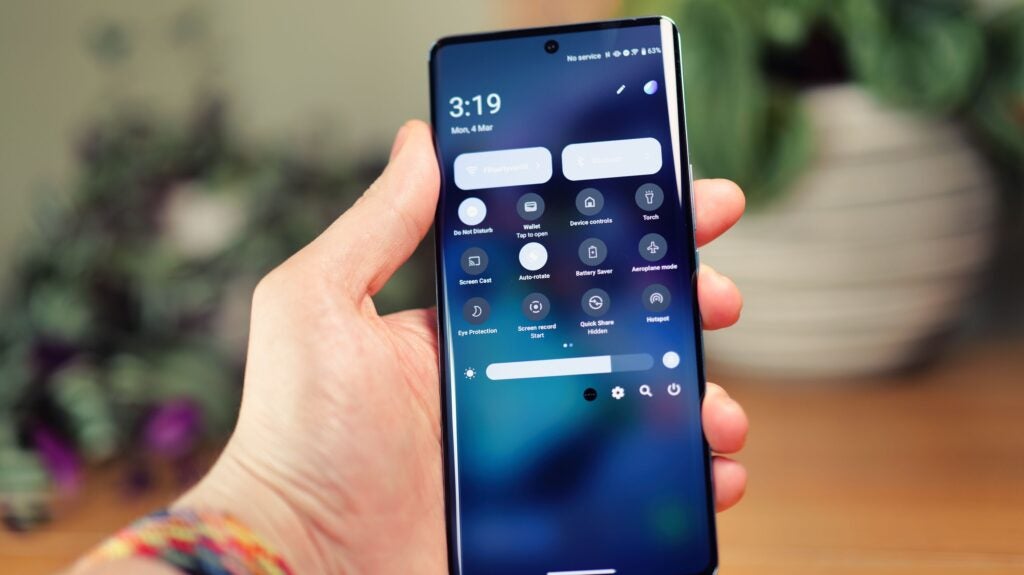
Battery life
- 5000 mAh battery
- 80W wired fast charging
- Charger included in the box
The Vivo V30 Pro somehow squeezes a 5000mAh battery pack into its svelte shell, and this large battery, combined with the efficient mid-range processor, results in excellent battery life.
I used the phone heavily throughout my testing, streaming HDR content on Netflix, taking loads of photos and videos and playing games, and it never failed to make it to the end of the day. What more can you ask for?
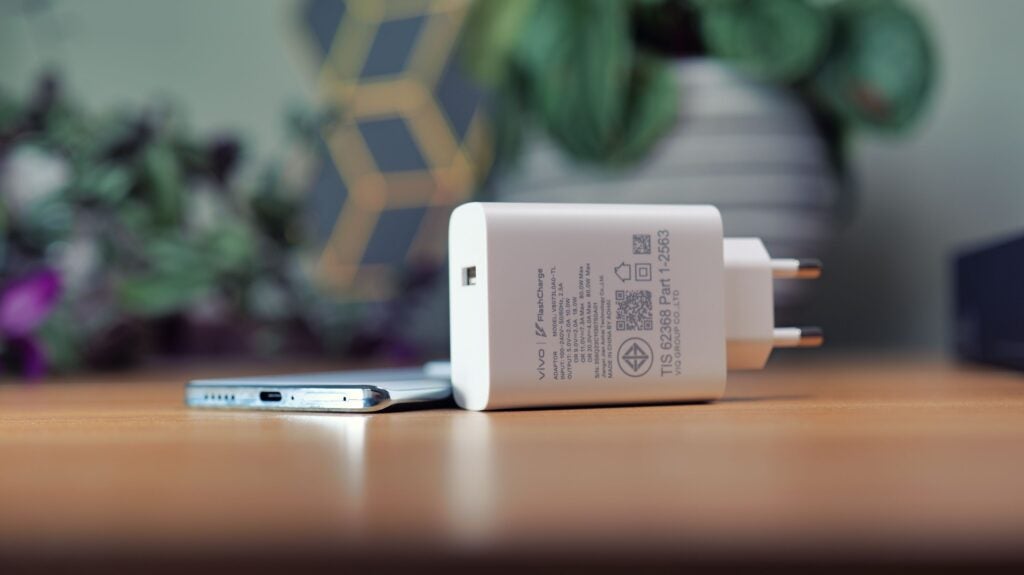
When it is time to charge, the task is accomplished in a flash, thanks to a generously included 80W wall adapter. Vivo says this charger will get you from fully flat to 100% charged in just 46 minutes, but by my count, it was even quicker. A full charge took me just 41 minutes; it’s great if you need to charge in a hurry.
Vivo is also confident about this battery’s longevity. According to its internal testing, it should retain 80% of its original capacity even after four years of constant use. The only thing that’s missing is wireless charging support, but that’s still a rarity in this price range.
Latest deals
Should you buy it?
You’re an avid selfie snapper
For my money, this is the best selfie camera on any current smartphone. If you love taking selfies, especially with large groups, this phone’s hard to beat.
You want a phone with great local support
The V-series phones rarely ever make their way to the UK, and they’re not available in the US either. So that might mean importing, and that could spell hassle if anything goes wrong.
Final Thoughts
The Vivo V30 Pro is probably the best photographic performer in its price bracket right now. The last few generations have impressed with flawless selfies, but now the rear cameras are highly impressive, too. Especially the main sensor, which is capable of capturing flagship-level images with lovely Zeiss-backed image processing and effects.
As usual, though, the lack of availability dampens things. If you live in a supported region, like Thailand or Indonesia, it’s an absolute bargain, but elsewhere, you’d need to import – and most people won’t be willing to go to such lengths for a midrange handset.
That said, if the phone is available in your region, and you want an affordable phone that takes great photos, the Vivo V30 Pro should be high on your list. The rear cameras give mid-range staples like the Pixel 7a a run for their money, and the selfie performance is truly unmatched.
How we test
We test every mobile phone we review thoroughly. We use industry-standard tests to compare features properly and we use the phone as our main device over the review period. We’ll always tell you what we find and we never, ever, accept money to review a product.
Find out more about how we test in our ethics policy.
Used as a main phone for over a week
Thorough camera testing in a variety of conditions
Tested and benchmarked using respected industry tests and real-world data
FAQs
The V30 Pro has an IP54 rating for dust and water resistance. This means it’s not fully waterproof but it can withstand sprays of water from all directions.
No, the Vivo V30 Pro doesn’t charge wirelessly, but its wired charging is very fast at up to 80W.
Vivo promises two major OS updates and three years of security patches for its V-series phones.
Trusted Reviews test data
Verdict
The Vivo V30 Pro is an affordable midrange handset with cameras that punch well above their weight. Especially the selfie camera, which might just be the best snapper of them all. With limited availability though, getting your hands on one might prove challenging.
Pros
- Triple 50MP camera system
- Slim stylish design
- Fast charging and great battery life
Cons
- Limited availability
- Plenty of bloatware
- Poor stabilisation at 4K@60fps
-
Triple Zeiss camera systemThis is the first V-series phone to benefit from Vivo’s Zeiss partnership, which means it has exclusive filters and bokeh effects just like the X-series. The hardware has been massively upgraded, too. -
Flawless selfiesThe V-series phones are well known for their selfie capabilities and the V30 Pro continues that tradition. It has a 50MP front-facing camera with autofocus that continually impresses. -
Long battery life and 80W chargingNot only does the V30 Pro have stellar battery life, but when you eventually run it down, it charges up in a flash. The powerful 80W wall adapter comes included in the box.
Introduction
Vivo’s V-series phones have impressed over the last few years by offering standout selfie performance at affordable prices. With the latest entrant, the V30 Pro, it looks like that photographic prowess is extending to the rear cameras, too. It’s even sporting a Zeiss logo, just like the brand’s flagship X100 Pro.
The last few generations of V-series devices have had solid main cameras, and great selfie cameras, but they were joined by the lacklustre 8MP ultrawide and 2MP macro combo that we see on so many mid-range phones. This year, things have changed, and every camera has a 50MP resolution. There are three on the back, including a new 2x portrait lens, and of course, a powerful selfie camera with autofocus around the front.
The V30 Pro was initially launched in Thailand and Indonesia, and it’ll be hitting other markets in the near future, but as with previous models, it’s not likely to make its way to the UK. In Thailand, it retails for 19,999 THB (about £440) which means it’s by far the most powerful camera arrangement in its price bracket.
I was intrigued to find out what it’s like to live with and see if the Zeiss magic that we saw with the Vivo X100 Pro has trickled down to this model, too. Here’s what I found out.
Design
- Super slim and lightweight
- Unique colourways and textures
- IP54 rating
Just like previous generations, the Vivo V30 Pro has a striking design and is exceptionally slim. There are four colour options to choose between and the range includes some pretty unique finishes. I have the Bloom White variant in for testing, and it has a 3D-etched pattern that looks like flower petals. It’s a really interesting design, and it’s covered with Vivo’s signature AG glass, so it has the same velvety-smooth feel as the X100 Pro.

The range also includes a UV-reactive model called Lush Green, which changes shade as the sunlight hits it, something we’ve seen on previous V-series models. Another flashy option is Waving Aqua, which has a shimmering wave-like pattern on the rear panel, that shifts around in different lighting. However, if you prefer a more professional look, you can choose Noble Black, which is just, well, black.
The camera array has a new look this time around, too. All the rear lenses are housed together in a square-shaped black glass panel, accompanied by that fancy Zeiss badge. It’s a bit like the Xiaomi 14 camera layout, only it’s much, much smaller, and barely protrudes at all from the back panel.

The bi-colour fill light, which Vivo calls Aura Light, makes a return on this model. However, this time it’s square-shaped, to match the camera layout. It also has a larger radius than the ring-shaped fill light on the Vivo V29 Pro, but I’ll explore whether or not that makes a practical difference later on.
As mentioned, it’s a very slim and lightweight handset, and there’s a pronounced curve to both the display edges and the rear panel. It feels great in the hand and in the pocket, but that velvety-feeling AG glass sure is slippery. Thankfully, it comes with a transparent TPU case in the box, and I kept that on most of the time, purely out of fear of dropping it, or having it spontaneously slide off my desk.
Screen
- 6.78-inch 2K 120Hz AMOLED
- 2800 nits peak brightness
- Curved edges, HDR10+support
The Vivo V30 Pro has an excellent AMOLED display with a 1260×2800 resolution and an adaptive refresh rate of 60-120Hz. It’s not quite on the level of LTPO panels, which can drop as low as 1Hz, but it means that you always get a smooth-looking experience without draining your battery excessively.

Vivo quotes the peak brightness output at a whopping 2800 nits, however, as usual, it’ll only hit that level during HDR playback in bright environments. Regardless, it’s a very bright panel that can easily compete with direct sunlight.
The phone has the correct Widevine DRM certification to allow apps like Netflix to play in HDR10, and it looks great doing so. Colours are vibrant, shadows are dark and detailed and the highlights shine brightly. No complaints here.
The edges of the display have a fairly pronounced curve, which leads to some slight colour shifting at the periphery. It’s far from the worst I’ve seen, but something to be wary of. In fairness, though, the curves make for a very slim-feeling device, and despite having a large screen, it’s much more manageable for people with smaller hands.

There’s a good amount of customisation in the settings menu so you can tweak the colour rendition to your liking. You get three main profiles to choose from, and you can adjust the colour temperature and tint of each one independently. There’s also a wealth of eye-care options that you can enable.
Cameras
- 50MP 1/1.49-inch f/1.9 main camera
- 50MP ultrawide and 2x portrait lens
- 50MP f/2.0 wide-angle selfie camera with autofocus
The biggest upgrade that this phone offers over its cheaper sibling and previous generations is in the camera setup. The V30 Pro has a trio of 50MP cameras on its rear and a 50MP selfie snapper on the front. It’s also the first model in the V-series to benefit from Vivo’s Zeiss partnership, which brings with it exclusive photo styles and image tuning.
Usually, V-series phones come with the all-too-common mid-range combo of a capable main camera, an 8MP ultrawide, and a 2MP macro. This time, though, the rear cameras have really taken a step up. You get a 1/1.49-inch main sensor with an f/1.9 aperture, an f/1.9 2x telephoto lens, and an f/2.0 ultrawide with a 119-degree FOV and autofocus.

Around the front, the selfie camera has a wide 20mm equivalent lens, and at its widest, Vivo calls it a 0.8x focal length in the UI. However, you can shoot at 1x and 2x with the touch of a button, and since the selfie camera has a whopping 50MP resolution, these crops are effectively lossless.
As was the case with the previous V-series phones that I tested, the selfie camera got me the most excited, and I took way more photos with the front-facing camera than I normally would. The wide FOV makes it perfect for group shots or showing off your surroundings, and since it has autofocus, your images are tack-sharp no matter where you’re standing.


It’s a way better selfie camera than the one on Vivo’s flagship handset, the X100 Pro, and it might just be one of the best selfie cameras on any phone. Impressive stuff, at such an affordable price point.
Around the back, despite all cameras offering a 50MP resolution, the main camera is by far the most impressive. This is especially true when the light gets a little lower, as its larger sensor does a better job of fending off noise and motion blur.
However, the ultrawide and 2x telephoto are both very useful to have. Both of these cameras can focus extremely close, too, allowing for some lovely macro shots that you can’t get with the main camera.
The camera app gives you a 4x button, which takes digitally cropped shots of the 2x optical telephoto, but I was less impressed with these photos. They’re ok if the lighting is perfect, but there’s a definite drop in quality. Your best bet is to move closer with the 2x lens, wherever possible.
The image quality across all cameras is aided by Vivo’s comprehensive suite of image editing tools, filters and beautification options. You can bring photos to life by adding a simple filter, and portrait mode cutouts are pretty reliable, too. It’s worth noting, though, that you can only adjust the bokeh effect after shooting on the rear lenses, which is slightly frustrating when you add too much blur to a selfie snap.
A unique feature of this phone is its Aura Light, which is a bi-colour continuous light source that can illuminate your photos and videos at night. It automatically detects the ambient lighting and adjusts the colour temperature of the LED ring to match, but you can also take control of it manually if you prefer.

In most situations, the Aura Light illumination doesn’t look too flattering, but it’s definitely a step above the usual LED flash. And in situations where you want a traditional flash, the phone has one of those, too.
For video capture, you can shoot at up to 4K@60fps on all cameras. However, I’d recommend sticking to 4K@30fps, as the stabilisation is far better. It seems like EIS is disabled entirely at 4K@60fps. Enabling Ultra Steady mode smooths things out even more, but then you’re limited to 1080p.
Performance
- MediaTek Dimensity 8200
- 12GB RAM
- 512GB storage
The Vivo V30 Pro runs on the MediaTek Dimensity 8200, and it’s paired with up to 12GB of RAM and 512GB of storage. It’s a sub-flagship chipset, but it’s more than capable enough, and it’ll outshine Qualcomm’s Snapdragon 7 Gen 3 and Google’s Tensor G2 in a lot of situations.

In day-to-day use, I had no complaints about the performance. Apps always opened quickly and navigating the operating system was smooth and stutter-free. I’m testing the 12GB model, and it can multitask like a champ, whether watching YouTube in a pop-out window or streaming a podcast while navigating with Google Maps.
The gaming performance was impressive, too. The phone can happily run Genishin Impact on the High graphics preset at 30fps, and if you switch to the Medium preset, you’ll get a solid 60fps. Of course, you can go higher, but expect some stuttering if you do.
The Vivo V30 Pro only has a single speaker, which is a little disappointing to see, especially after testing the Poco X6 Pro which has decent stereo speakers at a significantly lower MSRP.
That said, this speaker doesn’t sound too bad, and it’s definitely louder than expected. Amusingly the volume goes all the way to 150% if you keep hitting the button, but it begins to distort if you max it out. My main problem with the speaker is that it’s easily muffled if you’re holding the phone in the wrong place, and that can be annoying.
Software
- Funtouch OS 14
- Based on Android 14
- Lots of bloatware
The Vivo V30 Pro runs Funtouch OS 14, which is a skinned version of Android 14. It’s the same software found on the Vivo X100 Pro that lives in my pocket most of the time, so I wasn’t in for too many surprises.
It’s not the most exciting Android skin, but it’s highly customisable, so if you don’t like the way the app icons look, the UI animations or even the shape of the fingerprint reader icon, you can change them with ease.

While I praised the flagship X100 Pro for its lack of bloatware, that’s unfortunately not the case with the V30 Pro. It comes packed with all kinds of junk, including folders of “hot apps” and games. It’s not the end of the world; it can all be removed, and it’s somewhat understandable at such an affordable price point, but in an ideal world, it’s a hassle I could do without.
Vivo promises two major OS upgrades and three years of security patches for the V30 Pro. This software support lags behind some of the competition; Poco promises three OS updates and four years of security patches for X6 and X6 Pro, for example. Samsung takes things even further, with five years of security patches on its similarly priced A54 5G.

Battery life
- 5000 mAh battery
- 80W wired fast charging
- Charger included in the box
The Vivo V30 Pro somehow squeezes a 5000mAh battery pack into its svelte shell, and this large battery, combined with the efficient mid-range processor, results in excellent battery life.
I used the phone heavily throughout my testing, streaming HDR content on Netflix, taking loads of photos and videos and playing games, and it never failed to make it to the end of the day. What more can you ask for?

When it is time to charge, the task is accomplished in a flash, thanks to a generously included 80W wall adapter. Vivo says this charger will get you from fully flat to 100% charged in just 46 minutes, but by my count, it was even quicker. A full charge took me just 41 minutes; it’s great if you need to charge in a hurry.
Vivo is also confident about this battery’s longevity. According to its internal testing, it should retain 80% of its original capacity even after four years of constant use. The only thing that’s missing is wireless charging support, but that’s still a rarity in this price range.
Latest deals
Should you buy it?
You’re an avid selfie snapper
For my money, this is the best selfie camera on any current smartphone. If you love taking selfies, especially with large groups, this phone’s hard to beat.
You want a phone with great local support
The V-series phones rarely ever make their way to the UK, and they’re not available in the US either. So that might mean importing, and that could spell hassle if anything goes wrong.
Final Thoughts
The Vivo V30 Pro is probably the best photographic performer in its price bracket right now. The last few generations have impressed with flawless selfies, but now the rear cameras are highly impressive, too. Especially the main sensor, which is capable of capturing flagship-level images with lovely Zeiss-backed image processing and effects.
As usual, though, the lack of availability dampens things. If you live in a supported region, like Thailand or Indonesia, it’s an absolute bargain, but elsewhere, you’d need to import – and most people won’t be willing to go to such lengths for a midrange handset.
That said, if the phone is available in your region, and you want an affordable phone that takes great photos, the Vivo V30 Pro should be high on your list. The rear cameras give mid-range staples like the Pixel 7a a run for their money, and the selfie performance is truly unmatched.
How we test
We test every mobile phone we review thoroughly. We use industry-standard tests to compare features properly and we use the phone as our main device over the review period. We’ll always tell you what we find and we never, ever, accept money to review a product.
Find out more about how we test in our ethics policy.
Used as a main phone for over a week
Thorough camera testing in a variety of conditions
Tested and benchmarked using respected industry tests and real-world data
FAQs
The V30 Pro has an IP54 rating for dust and water resistance. This means it’s not fully waterproof but it can withstand sprays of water from all directions.
No, the Vivo V30 Pro doesn’t charge wirelessly, but its wired charging is very fast at up to 80W.
Vivo promises two major OS updates and three years of security patches for its V-series phones.



















